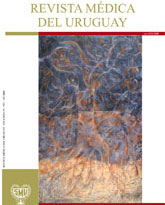Eficacia y seguridad del sling transobturatriz de malla simple de polipropileno (TOT) en el tratamiento de la incontinencia urinaria de esfuerzo femenina
Palabras clave:
CABESTRILLO SUBURETRAL, INCONTINENCIA URINARIA DE ESFUERZO, URODINAMICAResumen
Objetivo: analizar la eficacia, seguridad y complicaciones del sling transobturatriz (TOT) con malla simple de polipropileno como técnica quirúrgica en el tratamiento de la incontinencia urinaria de esfuerzo femenina.
Material y método: se analizó la evolución de una cohorte de 100 pacientes operadas de sling transobturatriz de malla simple de polipropileno entre octubre de 2002 y octubre de 2004. La técnica utilizada fue con agujas reutilizables y malla simple de polipropileno en lugar de los diferentes kit comerciales.
Se evaluó en cuatro cortes temporales la evolución de las pacientes considerando especialmente la eficacia de la técnica, la satisfacción de las mismas y la aparición de complicaciones.
Resultados: no hubo lesiones vasculares, ni nerviosas, ni digestivas durante la cirugía. Se registró un caso (1%) de lesión vesical por pasaje transvesical de la aguja. Un paciente presentó retención urinaria posoperatoria que requirió cateterización vesical; 7% presentó urgencia miccional posoperatoria inmediata; 3% de las pacientes presentó extrusión vaginal de la malla; 2% experimentó dolor obturatriz con los esfuerzos físicos, crónico.
Con respecto a la eficacia en 10% de las pacientes falló el procedimiento, 74% está asintomática, y 16% está mejor.
Del total, 70,2% se encuentra muy satisfecha, 17% está moderadamente satisfecha, 6,4% no está satisfecha, y 6,4% se siente peor.
Conclusiones: el TOT, con las modificaciones realizadas, es una técnica muy segura y efectiva con un seguimiento máximo de cinco años y medio, con una aceptable tasa de complicaciones, en el tratamiento de la incontinencia urinaria de esfuerzo femenina.
Citas
(2) De Lancey J. Structural support of the urethra as it relates to stress urinary incontinence: the hammock hypothesis. Am J Obstet Gynecol 1994; 170(6): 1713-20.
(3) De Lancey JO. Fascial and muscular abnormalities in women with urethral hypermobility and anterior vaginal wall prolapse. Am J Obstet Gynecol 2002; 187(1): 93-8.
(4) Ulstem U, Petros P. Intravaginal slingplasty (IVS): an ambulatory surgical procedure for treatment of female urinary incontinence. Scand J Urol Nephrol 1995; 29(1): 75-82.
(5) Nilsson CG, Kuuva N, Falconer C, Rezapour M, Ulmsten U. Long-term results of the tension-free vaginal tape (TVT) procedure for surgical treatment of female stress urinary incontinence. Int Urogynecol J Pelvic Floor Dysfunct 2001; 12 Suppl 2: S5-8.
(6) Delorme E. Transobturator urethral suspension: mini-invasive procedure in the treatment of stress urinary incontinence in women. Prog Urol 2001; 11(6): 1306-13.
(7) Dargent D, Bretones S, George P, Mellier G. Insertion of a sub-urethral sling through the obturating membrane for treatment of female urinary incontinence. Gynecol Obstet Fertil 2002; 30(7-8): 576-82.
(8) Mellier G, Benayed B, Bretones S, Pasquier JC. Suburethral tape via the obturator route: is the TOT a simplification of the TVT? Int Urogynecol J Pelvic Floor Dysfunct 2004; 15(4): 227-32.
(9) De Tayrac R, Deffieux X, Droupy S, Chauveaud-Lambling A, Calvanese-Benamour L, Fernández H. A prospective randomized trial comparing tension-free vaginal tape and transobturator suburethral tape for surgical treatment of stress urinary incontinence. Am J Obstet Gynecol 2004; 190(3): 602-8.
(10) Briozzo L, Vidiella G, Curbelo F, Craviotto F, Massena B, Varela López R, et al. Transvaginal Obturatriz Tape (TOT) en el tratamiento de la incontinencia urinaria de esfuerzo femenina. Rev Méd Urug 2005; 21(2): 130-40.
(11) Abrams P, Blaivas JG, Stanton SL, Andersen JT. Standardization of terminology of lower urinary tract function. Neurourol Urodynam 1988; 7: 403-427.
(12) Blaivas JG, Appell RA, Fantl JA, Leach G, McGuire EJ, Resnick NM. Definition and classification of urinary incontinence: recommendations of the Urodynamic Society. Neurourol Urodyn 1997; 16: 149-51.
(13) Mallett VT, Brubaker L, Stoddard AM, Borello-France D, Tennstedt S, Hall L, et al. The expectations of patients who undergo surgery for stress incontinence. Am J Obstet Gynecol 2008; 198(3): 308. e1-6.
(14) Uebersax JS, Wyman JF, Shumaker SA, McClish DK, Fantl JA. Short forms to assess life quality and symptom distress for urinary incontinence in women: the Incontinence Impact Questionnaire and the Urogenital Distress Inventory. Continence Program for Women Research Group. Neurourol Urodynam 1995; 14(2): 131-9.
(15) Nozar F, Regules E. Bases anatómicas del TOT. 2007: 7. Obtenido de: www.ginec.org/edumec.htm. 2007. (Consulta: julio de 2007).
(16) Barber MD, Gustilo-Ashby AM, Chen CC, Kaplan P, Paraiso MF, Walters MD. Perioperative complications and adverse events of the MONARC transobturator tape, compared with the tension-free vaginal tape. Am J Obstet Gynecol 2006; 195(6): 1820-5.
(17) Grise P, Droupy S, Saussine C, Ballanger P, Monneins F, Hermieu JF, et al. Transobturator tape sling for female stress incontinence with polypropylene tape and outside-in procedure: prospective study with 1 year of minimal follow-up and review of transobturator tape sling. Urology 2006; 68(4): 759-63.
(18) Giberti C, Gallo F, Cortese P, Schenone M. Transobturator tape for treatment of female stress urinary incontinence: objective and subjective results after a mean follow-up of two years. Urology 2007; 69(4): 703-7.
(19) Minaglia S, Ozel B, Klutke C, Ballard C, Klutke J. Bladder injury during transobturator sling. Urology 2004; 64(2): 376-7.
(20) Fischer A, Fink T, Zachmann S, Eickenbusch U. Comparison of retropubic and outside-in transoburator sling systems for the cure of female genuine stress urinary incontinence. Eur Urol 2005; 48(5): 799-804.
(21) Mellier G, Benayed B, Bretones S, Pasquier JC. Suburethral tape via the obturator route: is the TOT a simplification of the TVT? Int Urogynecol J Pelvic Floor Dysfunct 2004; 15(4): 227-32.
(22) Latthe PM, Foon R, Toozs-Hobson P. Transobturator and retropubic tape procedures in stress urinary incontinence: a systematic review and meta-analysis of effectiveness and complications. BJOG 2007; 114(5): 522-31.












